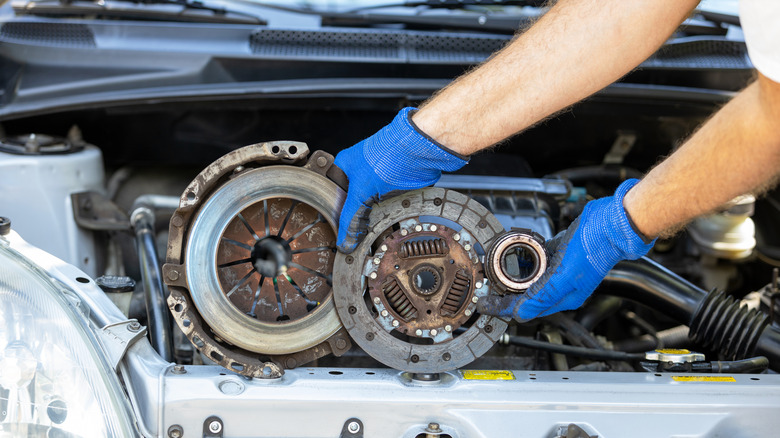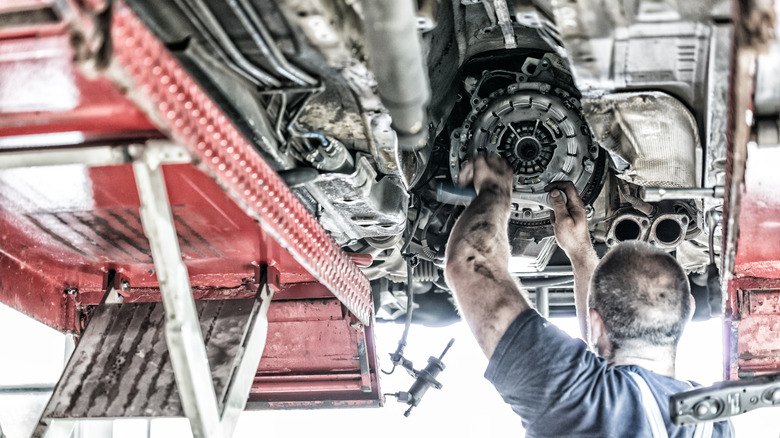What's A Throwout Bearing & What Happens If One Goes Bad?
Anyone who has driven a car with a manual transmission for more than a day will tell you that it's exceptionally fun. When you can get on the open road and shift gears to pick up speed, there's something fulfilling about it. In order for the manual gearbox to work, there's the clutch pedal, which operates the clutch housing. Within the clutch housing is the clutch plate, pressure plate, flywheel, and a throwout bearing. All of these components work together and connect to the engine's wheels, but the throwout bearing might be the single-most significant part within the housing.
The throwout bearing, sometimes referred to as the clutch release bearing, disconnects the engine from the wheels when the driver presses down on the clutch pedal to shift gears. It's positioned between the clutch pressure plate and the clutch fork. If it's a newer vehicle, instead of the clutch fork, it would be the hydraulic slave cylinder – that is if you can find a newer car with a manual gearbox. Even before Ferrari moved away from selling cars with a manual transmission, cars with a stick were on the decline. If you've had your manual transmission for a while and are concerned about the throwout bearing wearing out, read ahead to see what needs to be done.
Signs of a failing throwout bearing
There are many common issues that come with a manual transmission. Just like any mechanical component, the throwout bearing can deteriorate naturally from age. This deterioration will affect the performance of a car in one way or another. When a throwout bearing starts going bad, there are a few signs drivers can pick up on so they know when to take their car into the shop. Unusual noises from pressing in the brake pedal then disappearing when it's released can be one symptom of a bad throwout bearing. In some cases, when the bearing is unable to align with the pressure plate, it will cause the clutch pedal to vibrate whenever it's pressed down. When it becomes an Olympic event shifting gears, there's cause for concern.
When the throwout bearing doesn't engage correctly, the gear shifter will be stiff or even vibrate. If odd noises come from shifting gears, then it being difficult to shift is just around the corner. A similar issue can happen with the clutch pedal. When it takes more pressure to depress, the throwout bearing is likely failing. This issue can get bad enough that the clutch pedal can't be pressed in completely, which will render the car inoperable until it's fixed. Lastly, if there's a burning smell, it could be from the friction between the bearing and the clutch system due to there not being enough lubricant.
What causes a throwout bearing to go bad?
Everyday wear and tear will cause the throwout bearing to deteriorate. However, there are a few other causes that if avoided can extend the bearing's lifespan. Ensuring that there is always plenty of transmission fluid in the vehicle is helpful for a long-lasting throwout bearing. Just like the engine itself, the throwout bearing needs lubricant. Low transmission fluid levels might require extensive work on the transmission. Ignoring the transmission fluid level is, after all, one of the many bad habits people have that harms the transmission.
Ever drive on an unpaved road and listen to all the gravel fly up, hitting the underside of your car? Or see all the dust flying around in your wake? We like to think that our cars are invincible, but there's some definite risk that comes with driving on such terrain. If a clutch housing isn't properly sealed, dirt, dust, or some other kind of debris can find itself in there and cause some serious damage. Being mindful of the clutch and the way you use it can keep the throwout bearing in tip-top shape for just a little bit longer than usual.
For example, if you notice the clutch slips periodically, be mindful that slipping can cause friction, which will lead to overheating, in turn leading to potential damage to the bearing.
Repairing the throwout bearing
The problem with the throwout bearing getting damaged and needing a repair is that there's no repairing it. Drivers can replace it, but that's a difficult task as it's sealed within the clutch housing. If it needs fixing, the only way to do so is by removing the entire transmission and taking it apart. If this is done, it's best to also replace the clutch pedal, minimizing further malfunctions to the bearing. It's as expensive as it sounds.
The part itself is commonly only $65, depending on where you live and the shop you get it from, but then labor costs for a job that takes roughly six hours, you're looking at paying around $500. It's possible for owners to fix it on their own if they're the DIY type, but it's not recommended unless they have some automotive experience, specifically with the transmission. It will definitely save costs. Just go in knowing how big of a job it is.



